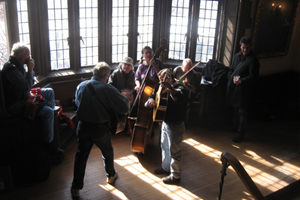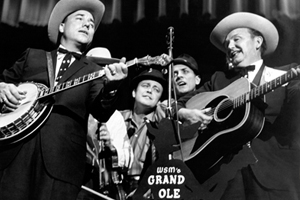Folk roots
After 50 years, the student-run Folk Festival remains true to its original mission.
By Jason Kelly
Photography by Folklore Society and Getty Images

Jam sessions create an improvisational spirit at the Folk Festival, which turns 50 this year.
On their way to the University of Chicago Folk Festival in 1963, Laura Gloger’s date asked her what kind of music she liked. “I almost said, ‘Everything but that corny fiddle music,’” but she liked the guy enough to resist.
They arrived at Mandel Hall during bluegrass legend Bill Monroe’s performance. The spotlight was trained on fiddler Kenny Baker, who stood in a cloud of rosin dust and mesmerized the crowd, the skeptical Gloger included, with his extended solos. “I had no idea,” she says.
Gloger picked the festival over the guy—and, to this day, she doesn’t miss either one. She’s been a volunteer for the student-run Folklore Society since the late 1960s, when another boyfriend “dragged me along to help schlep stuff.” Through the years she has maintained her convert’s passion for that corny fiddle music and the blues, Cajun, old-time, klezmer, Irish, gospel, and other deeply rooted traditions the festival celebrates.
February 12–14 marks the festival’s 50th anniversary, an occasion for longtime patrons like Gloger and Nina Helstein, U-High’60, AB’64, AM’75, PhD’95, to reminisce. Helstein, a lifelong Hyde Park resident and a bluegrass lover since she encountered the music at age 17, has been to “every concert of every festival.”
She can’t describe what makes bluegrass so moving to her, but the emotion it stirs is strong. “I don’t know. I can only tell you that I feel so alive when I’m listening to it.”

Earl Scruggs, left, flew himself and Lester Flatt to the 1967 festival in a blizzard.
To Helstein it’s not the stars that stand out from a half-century of performances; it’s the authenticity and serendipity that make the festival memorable. Impromptu jam sessions often pop up in Ida Noyes nooks, an improvisational blend of styles creating a rare intimacy among performers and fans. A sense of kinship forms across traditions and regions, forging a bond as tight as a banjo string. Says Helstein: “Magical things happen.”
To aficionados like her, the performances don’t feel like listening to music so much as eavesdropping on private conversations. “There’s something so real about this music; it’s from the lives of these folks, what they play on their porch,” she says. “It’s their life music.”
In 1967 some musicians actually risked their lives to make the Mandel Hall stage their weekend porch. It may sound hyperbolic, but many tales about that year’s show—which went on despite 23 inches of snow—have been exaggerated over time. “This is folklore, after all,” says Mark Greenberg, AB’67, AM’70, the festival president during the blizzard. It was Planes, Trains, and Automobiles with a twang. Lugging their equipment, musicians trudged along University Avenue, some local, some from out of town, all weather-weary. Backstage one evening, Gloger heard a knock at the door. “I open it and here’s this guy, covered in snow. It was Buddy Guy; he walked over from his house.”
Others had a longer haul but were no less determined to make it. Earl Scruggs—“the great hero of the five-string banjo,” Greenberg says—rented a plane and flew it himself from Nashville to Meigs Field. Two-thirds of the New Lost City Ramblers arrived by train. From the Englewood Avenue station, they continued on foot with assistance from Gloger and others who “kind of safaried” along with the band’s luggage on their heads.
Cajun fiddler Dewey Balfa and the Mamou Cajun Band drove from Louisiana, “fueled by White Mule home brew,” Greenberg says. The program had been altered to accommodate the chaos, but the band went on as scheduled.
“They practically walked from their car to the stage. They were so juiced in so many ways, it was an extraordinary performance.” The atmosphere created a “pioneer, survivor feeling” among musicians and audience members alike, both of whom arrived in increasing numbers as the weekend progressed.
The festival has always fostered a pioneering spirit. It began amid a commercial folk revival with a mission to honor the music’s origins over its profit margins and originality over popularity. As a New York Times reviewer wrote on February 12, 1961: “In a period when the popularization of folk music has led to many specious species of dilution and hybridization, the bulk of the music at the festival was as pure and refreshing as a swig of spring water. The key words were tap-roots, tradition, authenticity, and non-commercial at the weekend’s three long evening programs.”
Those three evening programs at Mandel Hall—along with daytime workshops and jam sessions at Ida Noyes that were part of the first festival—remain as originally established. So does the essence of the musicians, such as one of this year’s featured performers, banjo and fiddle player Dan Gellert. Fiddler magazine described Gellert as “taking the time to understand the music in a complete and detailed way, as if it were a language.”
The southwestern Virginia bluegrass James King Band also will perform, along with the New Mules, a downstate Illinois string ensemble. Other acts remain to be finalized, but a theme has emerged in the Folklore Society’s planning meetings. “We didn’t necessarily set out to do this, but we’re basically hiring our favorites,” says current copresident Ezra Deutsch-Feldman, AB’09. “It’s a celebration of the kind of music we’re about.”
Greenberg, who runs the Vermont-based folk-music and arts production and consulting company Upstreet Productions, considers the festival “a major, if not widely known, cultural institution” because of that steadfast adherence to substance over fashion.
Bands have come and gone, genres have ebbed and flowed with new generations. Through those shifting fads, the Folk Fest’s animating spirit persists. Gloger’s boyfriends may have changed, but, as she says, “I kept the same festival all these years.”
